Art
Art and Amour of
Rabindranath Tagore
Fayza Haq
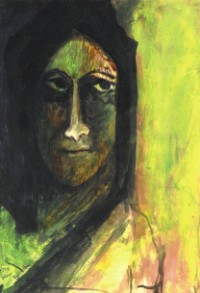 |
Untitled– portrait of a woman. Photo: courtesy |
Not many are aware of the importance of art in the life of the Bard of Bengal, Rabindranoth Tagore. We tend to know Tagore as “Probondhokar” but he should also be called “chitrakor” or painter too. Art played a vital role in the later stages of his life. Imagine being a senior citizen and finding a career of one's own. It's like the American woman painter who discovered art in her seventies, and did paintings of such depth and mastery that the world cannot forget her. Tagore's paintings have been compared to the Expressionists of Germany, Holland and France. He was recognised as an excellent painter in Europe, much before his work with the black pen and washes got any acclaim in the Subcontinent. The paintings and drawings gave way to his emotions and feelings in a manner that writing, hundred years back, would not allow. This is despite the fact that Freud and Russian writers like Tolstoy had broken all barriers of human society even in those stultifying Edwardian times.
Anyone interested in the works of Rabindranath Tagore is aware of his mastery over faces and figures, which are vibrant, possessing a life of their own. His art work has mesmerised all Europe and the Subcontinent. His brush and pen works expressed his subconscious and suppressed desires and emotions as even his writings did not–they are world-famous but not quite as hypnotic and soul-stirring.
“One feels that all Tagore expressed in his innumerable poems, plays, short stories could not be expressed in words and needed something even more subtle, which only the tools of a painter can handle.” says Rokeya Sultana, Professor of fine arts at DU. This she said in the warm summer May day, sitting in her class room, while teaching print -making to a fresh batch of students in the “Charukola”.
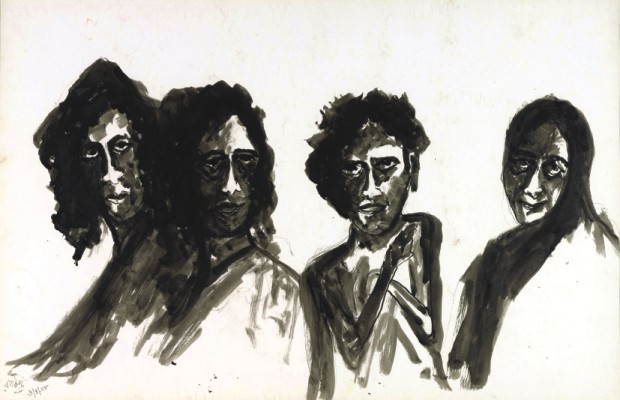
Untitled– four figures. Photos: courtesy
“Rabindranath himself has said that the freedom he got in his paintings was something he did not get in his writings. In this way he made the world of art even richer in Bengal, with a character of its own, because surrealism and expressionism is rampant in his art, as we learn from books. Surely there is nothing more in contemporary art, even in our twenty-first century,” says Rokeya. In the list of modern art by western experts Tagore is listed, as any other world-class painter–as he well deserves to be. Tagore was not quite satisfied with the Bengal School of Art. His vision was forward and westward looking. He did not wish to be caught up in our golden heritage only. Tagore felt that there is hope and beauty in the future too. He felt that human beings were more than the beautiful women in the Bengal School. He had the courage to bring out the animal instinct and crudeness, so to speak, in man.
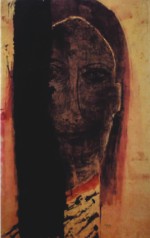 |
Portrait-3 |
All human instincts, if delineated in their stark forms, are not necessarily beautiful and pure–but they do exist and have existed – although society has wished to sweep them under the camouflaging rug. We appreciate the artist Edward Munch, with his “Scream”, as never before. With war, epidemics, and other man-made and natural disasters destroying the home and hearth, from one end of the earth to another–what best could depict our fears for the future? Rabindranath's characters were seldom physically appealing. They bore the pain, fear and disgust of man, which would have been impossible in words. He sought the inner side of man, says Rokeya. What the Bengali poets like Rabindranath and Jibanananda Das have written can never be surpassed and their writing gives wings to painters of Bengal today, who bring out the beauty of the countryside of Bengal, as no other poets have done. Without having read Tagore, a Bengali remains incomplete, says Rokeya, as she has insisted for the two decades; one has known her penchant for poetry.
Tagore, we know, has written poetry of various genres, some for “puja”, others dealing with “prem”, seasons–they are, says Rokeya, like paintings by Van Gogh – which are eternal and modern–no painter can surpass Van Gogh, albeit his sufferings and failure in different walks of life. She firmly believes, as do many other art enthusiasts, that Rabindranath's paintings have reached even greater heights than his poetry – in expressing mankind's feelings. What we call his doodles expressed the poet's inner desires, fears and feelings. They were not empty, meaningless scribbles. They were without feelings. Some of the drawings' titles were given by the poet- playwright himself, says Rokeya. The birds and animals were created out of his own imagination, she says. There are many things in our lives, which remain incomplete and untold and unheard. One does not carry one's feelings in one's sleeves, fearing that they might get trampled in the world's desperate hurry to get some place.
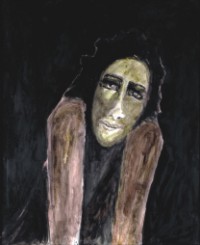 |
Untitled– portrait of a woman. Photo: courtesy |
“If words could express Rabindranaths' feelings, he would surely have done that”, says Rokeya. “If the poet could have been involved in another serous love affair or if he were married again, perhaps this suppressed desire would not have existed. In my 'Relation' series I've shown our suppressed feelings", says Rokeya. Imagine how society was a century back. Rabindranath was surely ahead of his time and encouraged the emancipation of women, as few other writers in the Subcontinent have done. His writings were often clarion calls for women's liberation. Everyone looked up to him as if he were some demi-god. As a human being, it was difficult for him to behave like an average human being, says Rokeya. In pictures, in an abstract way, choice of colours and form, he could express what he wanted and felt. He used Chinese ink to delineate his feelings, as in the manner of an Expressionist artist. The medium contains spirit, which helped Tagore do his work rapidly, as his feelings came and left. This was done layer upon layers and the layers dried rapidly, as one knows. This was unique for Bengal. The colours, says the professor, were earthy colours, some pale blue, orange, and light brown–with the orange peeping from below. The works were never dull, despite the artist's penchant for using dark hues.
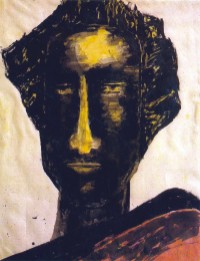 |
Study-II, Photo: courtesy |
Rokeya feels the poet's feelings strongly, having studied at “Santiniketan”, which the 'kobi-guru'- dreamt of and created. Even before going there, she loved his poetry and his songs. She chose this for her place of meditation, as the source of concentration and comprehension of fine arts. This is called “asram kendrik shikha”–where one lives a simple life and meditates, and concentrates. One went close to nature and wore simple slippers and white, flowing saris for apparel. Classes are held under trees, and the grass is covered with fallen leaves. Feeling nature closely in all her paintings, Rokeya felt that this, her student days in Santiniketan “ was a God-given chance to learn painting. The climate, in that place is extreme. During the hot weather the red earth cracks and snakes appear.” He lived in wet and heated boats, during his trips and so he organised his life in tune with nature, says the professor.
Some say that Rabindranath was a writer of love poems. His dedications, whether they are for nature, the seasons, God or human beings, involve love – in one form or another. Love remains a prime factor in his poetry, some say. It is recorded that many women sent him 'billet –doux', and he replied to them, in his own way. In case of Florence Nightingale, Helen Keller, Victoria O Kempo in South America, were ladies who admired him.
However, all said and done, Tagore exposed the plight of woman and argued for their liberation through his letters, short stories and essays. Trough his novels “he was able to construct new and vital role models to inspire a new generation of Bengali women" (Kathleen O'Connell). Later, by his act of admitting females into his “Santiniketan” school, he became a pioneer of co-education.
|
Copyright
(R) thedailystar.net 2011 |
